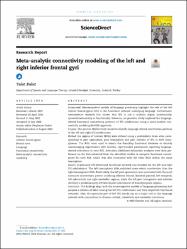| dc.contributor.author | Bulut, Talat | |
| dc.date.accessioned | 2022-09-05T13:01:18Z | |
| dc.date.available | 2022-09-05T13:01:18Z | |
| dc.date.issued | 2022 | en_US |
| dc.identifier.citation | Bulut, T. (2022). Meta-analytic connectivity modeling of the left and right inferior frontal gyri. Cortex, 155, 107-131. http://doi.org/10.1016/j.cortex.2022.07.003 | en_US |
| dc.identifier.issn | 0010-9452 | |
| dc.identifier.issn | 1973-8102 | |
| dc.identifier.uri | http://doi.org/10.1016/j.cortex.2022.07.003 | |
| dc.identifier.uri | https://hdl.handle.net/20.500.12511/9692 | |
| dc.description.abstract | Background: Neurocognitive models of language processing highlight the role of the left inferior frontal gyrus (IFG) in the functional network underlying language. Furthermore, neuroscience research has shown that IFG is not a uniform region anatomically, cytoarchitectonically or functionally. However, no previous study explored the language-related functional connectivity patterns of IFG subdivisions using a meta-analytic connectivity modeling (MACM) approach. Purpose: The present MACM study aimed to identify language-related coactivation patterns of the left and right IFG subdivisions. Method: Six regions of interest (ROIs) were defined using a probabilistic brain atlas corresponding to pars opercularis, pars triangularis and pars orbitalis of IFG in both hemispheres. The ROIs were used to search the BrainMap functional database to identify neuroimaging experiments with healthy, right-handed participants reporting language-related activations in each ROI. Activation likelihood estimation analyses were then performed on the foci extracted from the identified studies to compute functional convergence for each ROI, which was also contrasted with the other ROIs within the same hemisphere. Results: A primarily left-lateralized functional network was revealed for the left and right IFG subdivisions. The left-hemispheric ROIs exhibited more robust coactivation than the right-hemispheric ROIs. Particularly, the left pars opercularis was associated with the most extensive coactivation pattern involving bilateral frontal, bilateral parietal, left temporal, left subcortical, and right cerebellar regions, while the left pars triangularis and orbitalis revealed a predominantly left-lateralized involvement of frontotemporal regions. Conclusion: The findings align with the neurocognitive models of language processing that propose a division of labor among the left IFG subdivisions and their respective functional networks. Also, the opercular part of left IFG stands out as a major hub in the language network with connections to diverse cortical, subcortical and cerebellar structures. | en_US |
| dc.language.iso | eng | en_US |
| dc.publisher | Masson SpA | en_US |
| dc.rights | info:eu-repo/semantics/closedAccess | en_US |
| dc.subject | Broca's Area | en_US |
| dc.subject | Functional Connectivity | en_US |
| dc.subject | Inferior Frontal Gyrus | en_US |
| dc.subject | Language | en_US |
| dc.subject | Meta-Analytic Connectivity Modeling | en_US |
| dc.title | Meta-analytic connectivity modeling of the left and right inferior frontal gyri | en_US |
| dc.type | article | en_US |
| dc.relation.ispartof | Cortex | en_US |
| dc.department | İstanbul Medipol Üniversitesi, Sağlık Bilimleri Fakültesi, Dil ve Konuşma Terapisi Bölümü | en_US |
| dc.authorid | 0000-0003-0904-9399 | en_US |
| dc.identifier.volume | 155 | en_US |
| dc.identifier.startpage | 107 | en_US |
| dc.identifier.endpage | 131 | en_US |
| dc.relation.publicationcategory | Makale - Uluslararası Hakemli Dergi - Kurum Öğretim Elemanı | en_US |
| dc.identifier.doi | http://doi.org/10.1016/j.cortex.2022.07.003 | en_US |
| dc.institutionauthor | Bulut, Talat | |
| dc.identifier.wosquality | Q1 | en_US |
| dc.identifier.wos | 000859825300002 | en_US |
| dc.identifier.scopus | 2-s2.0-85135883554 | en_US |
| dc.identifier.pmid | 35985123 | en_US |
| dc.identifier.scopusquality | Q1 | en_US |


















